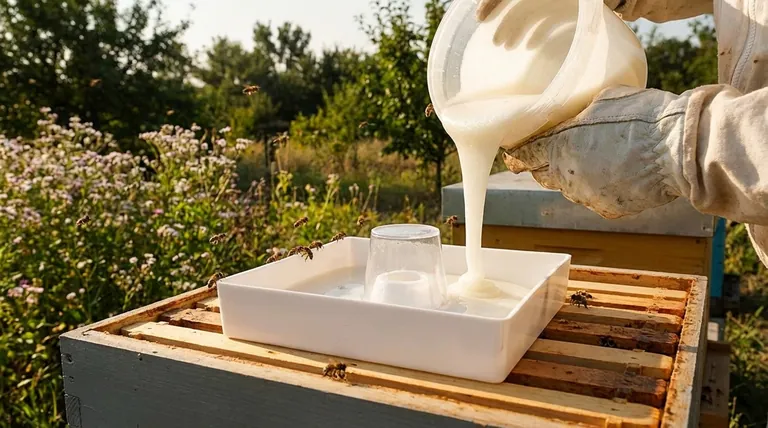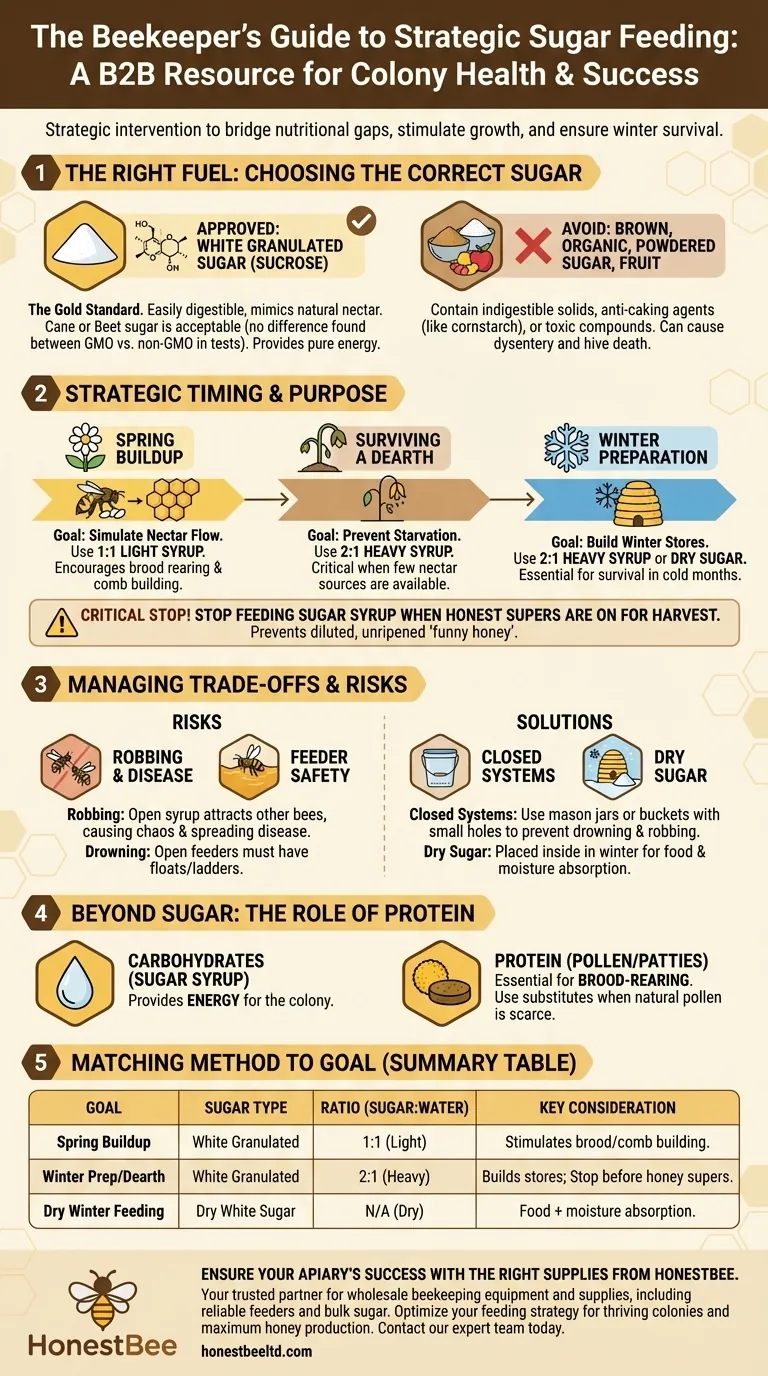Yes, feeding sugar to bees is a standard and often necessary beekeeping practice. It is not a replacement for honey but a critical tool used to provide carbohydrate energy when natural nectar is scarce or a colony's own stores are insufficient. The key is to use the right kind of sugar at the right time and for the right reason.
Feeding bees is not about spoiling them with treats; it is a calculated intervention to support colony health. Your goal is to strategically bridge nutritional gaps, stimulate growth, or ensure winter survival without creating dependency or contaminating your honey harvest.

The Right Fuel: Choosing the Correct Sugar
The type of sugar you feed your bees is not a matter of preference—it is a matter of their health. A bee's digestive system is sensitive and cannot process many of the compounds humans can.
The Gold Standard: Plain White Sugar
The safest and most effective food supplement is plain white granulated sugar, also known as sucrose. It is easily digestible for bees and closely mimics the carbohydrate composition of natural nectar.
The cheapest cane or beet sugar you can find is perfectly acceptable. It provides the pure energy the bees need without any harmful additives.
Sugars to Absolutely Avoid
Never feed bees brown sugar, organic sugar, or powdered (confectioner's) sugar. These contain indigestible solids or anti-caking agents (like cornstarch) that can cause dysentery and kill your bees.
Likewise, do not feed bees ground fruit or other sugary human foods, as these can contain compounds that are toxic to them.
The Cane vs. Beet Sugar Debate
Some beekeepers express concern over beet sugar because most of it is derived from genetically modified plants. However, sugar (sucrose) is a simple molecule.
Laboratory tests have found no discernible difference in the health or behavior of bees fed sugar from GMO vs. non-GMO sources. Many large-scale beekeepers use beet sugar without any issues.
Strategic Timing: When to Feed (and When Not To)
Feeding is a tool, and like any tool, its value depends on using it at the proper time.
Scenario 1: Spring Buildup
Feeding a light sugar syrup in early spring can simulate a nectar flow. This encourages the queen to lay eggs and stimulates the bees to begin building out new comb.
Scenario 2: Surviving a Dearth
A "dearth" is a period when few nectar-producing plants are in bloom. During this time, feeding can prevent a large, active colony from starving.
Scenario 3: Winter Preparation
In autumn, feeding a heavy sugar syrup helps the bees build up their winter honey stores. This is critical for colonies that did not gather enough nectar to survive the long, cold months ahead.
Critical Stop: When Honey Supers Are On
You must stop feeding sugar syrup when you add honey supers to the hive that are intended for human harvest. If you continue feeding, the bees will store that sugar water in the comb, resulting in a diluted, unripened product often called "funny honey."
Understanding the Trade-offs and Risks
While necessary, supplemental feeding introduces risks that must be actively managed.
The Danger of Robbing and Disease
Leaving syrup out in the open, or having a leaky feeder, can attract bees from other hives. This "robbing" behavior creates chaos in the apiary, can weaken or kill your colonies, and is an effective way to spread diseases between hives.
Feeder Design and Bee Safety
There are many ways to deliver syrup, from internal frame feeders to external jars and buckets. Open-style feeders inside the hive must have floats or ladders to prevent bees from drowning in the syrup.
Closed systems, like mason jars or buckets with small holes in the lid, are generally safer and help prevent both drowning and robbing.
Dry Sugar for Winter Feeding
In cold climates, some beekeepers place dry sugar (a method sometimes called the "mountain camp" method) inside the hive during winter. This provides food and helps absorb excess moisture, which can be just as deadly to a winter cluster as starvation.
Beyond Sugar: The Role of Protein
It is crucial to distinguish between energy and nutrition for growth.
Carbohydrates vs. Protein
Sugar syrup provides carbohydrates for energy. Pollen provides protein for brood-rearing. A colony cannot raise new bees on sugar alone.
Using Pollen Patties
When natural pollen is scarce, beekeepers can provide pollen substitutes, often in the form of a moist pollen patty. These patties are typically a mix of protein-rich powder and sugar syrup, placed directly on the top bars of the frames to encourage the queen to lay.
Matching Your Method to Your Goal
Your feeding strategy should directly reflect the colony's immediate need.
- If your primary focus is colony survival through winter: Feed a heavy, 2:1 sugar-to-water syrup in the fall to build stores, and consider using dry sugar inside the hive during deep winter.
- If your primary focus is stimulating a new or weak hive in spring: Feed a light, 1:1 sugar-to-water syrup to mimic a natural nectar flow and encourage comb building.
- If your primary focus is producing pure honey for harvest: Stop all feeding the moment you put on your honey supers and do not resume until after you've harvested the honey.
Strategic feeding transforms you from a bee-haver into a true beekeeper, actively managing your colony's health and success.
Summary Table:
| Feeding Goal | Recommended Sugar Type | Syrup Ratio (Sugar:Water) | Key Considerations |
|---|---|---|---|
| Spring Buildup | White Granulated Sugar | 1:1 (Light Syrup) | Stimulates brood rearing and comb building. |
| Winter Preparation | White Granulated Sugar | 2:1 (Heavy Syrup) | Builds winter stores; stop before adding honey supers. |
| Emergency Dearth | White Granulated Sugar | 2:1 (Heavy Syrup) | Prevents starvation when natural nectar is scarce. |
| Dry Winter Feeding | Dry White Sugar | N/A (Dry) | Provides food and absorbs moisture in cold climates. |
Ensure your apiary's success with the right supplies from HONESTBEE.
As a commercial beekeeper or equipment distributor, strategic feeding is crucial for colony health and honey production. HONESTBEE supplies high-quality, bee-safe beekeeping supplies and equipment through our wholesale-focused operations. We provide everything from reliable internal frame feeders to bulk white sugar, ensuring your colonies thrive season after season.
Let us support your operation's growth and efficiency. Contact our expert team today to discuss your wholesale needs and optimize your feeding strategy.
Visual Guide

Related Products
- HONESTBEE Professional Hive Top Bee Feeder Feeding Solution
- HONESTBEE Round Hive Top Bee Feeder for Syrup
- HONESTBEE Entrance Bee Feeder Professional Hive Nutrition Solution for Beekeeping
- Rapid Bee Feeder White Plastic 2L Round Top Feeder for 8 or 10-Frame Bee Hives
- Classic Boardman Entrance Bee Feeder Hive Front Feeding Solution
People Also Ask
- Why is a top feeder essential for bees? Ensure Colony Health and Efficiency
- What should be done with feeders and equipment after feeding bees? Essential Steps for Apiary Health
- Do I need an inner cover with a hive top feeder? Optimize Your Hive Setup for Healthy Bees
- What features make top feeders a reliable choice for beekeepers? A Guide to Safe, Efficient Hive Nutrition
- What is the best way to top feed bees? A Safe, High-Volume Feeding Solution for Your Apiary



















